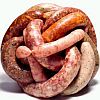speck or ciauscolo
3 posts
• Page 1 of 1
speck or ciauscolo
Looking for a recipe for either, speck preferably. Any assistance is appreciated, thanks.
- Scotty2
- Registered Member
- Posts: 171
- Joined: Wed Jan 07, 2009 12:17 pm
Hi
Len Poli has a recipe for Ciauscolo here:
http://lpoli.50webs.com/index_files/Sal ... uscolo.pdf
From http://ham.wetpaint.com/page/Speck
From http://www.leitesculinaria.com/writings ... speck.html
See also:
http://www.speck.it/45d528.html
Hope this helps
Phil
Len Poli has a recipe for Ciauscolo here:
http://lpoli.50webs.com/index_files/Sal ... uscolo.pdf
From http://ham.wetpaint.com/page/Speck
Produced in Northern Italy and Southern Austria from the rear leg of the hog, these boneless hams are aged for at least 22 weeks and up to a year. The hams are cured with juniper and salt and then cold-smoked over beech and maple. The resulting ham is firm, with a sweet herbal flavor and a pronounced smokiness. The name Speck means bacon in German, though speck bears little resemblance to traditional bacon, a fattier cut from the belly of the pig. The Italian Speck, produced in the Alto Adiege region of the country and known locally as baffe, very recently became available in the United States. The Austrian version, which is also available stateside, is a worthy alternative.
From http://www.leitesculinaria.com/writings ... speck.html
Speck starts as a lean boned haunch, branded with its place of origin and first production date. Next, those legs are hand-rubbed with salt and spice (spices differ from maker to maker, but generally include secret ratios of juniper berries, pepper, pimiento, laurel and rosemary). For three weeks, the hams are turned periodically as they absorb their spices, before being moved into a smoking room. But unlike the smoky-flavored northern and central European hams, South Tyrolean speck is smoked using low-resin woods like beech, in rooms kept below 68 degrees, where plenty of cool fresh air is drawn inside (air just like what circulated in Santa Maddalena at the Speckfest, although minus the oompahs and toots of the very able brass band).
Then aging starts. While a thin layer of mold forms on the surface of the hams � Speckgesch�ftsf�hrer Mitterrutzner further clarifies that speck is the only raw ham in the world in which mold is part of the production process, but humbly asks you to forget this while eating � the speck ages for 22 weeks in cool, humid rooms, where it loses more than a third of its weight. Then the mold is washed off, a five-person team comes to inspect the hams, and brands the legs four times more to show they're ready to swallow up. Your typical speck leg weighs 10 pounds at the end of the process, and about 2.2 million of them are made in the South Tyrol each year. The real McCoy is South Tyrolean Speck PGI, or Speck Alto Adige IGP (for "indicazione geografica protetta"). The rest is 100-percent ersatz.
See also:
http://www.speck.it/45d528.html
Hope this helps
Phil
-

wheels - Global Moderator
- Posts: 12894
- Joined: Sat Sep 02, 2006 4:29 pm
- Location: Leicestershire, UK
thanks, wheels, I don't know how I missed the Poli recipe, I must've seen it a dozen times, too..........thanks
- Scotty2
- Registered Member
- Posts: 171
- Joined: Wed Jan 07, 2009 12:17 pm
3 posts
• Page 1 of 1
Return to Recipes for cured meats
Who is online
Users browsing this forum: No registered users and 12 guests

